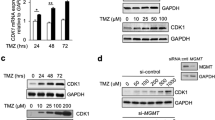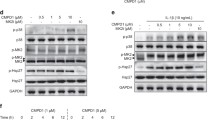Abstract
We examined the mechanism of action of nitrosoureas as represented by 1-(4-amino-2-methyl-5-pyrimidinyl) methyl-3-(2-chloroethyl)-3-nitrosourea (ACNU) with respect to p53 and the G2M cell cycle checkpoint using two glioblastoma cell lines: U251MG and U373MG, with mutated p53. At log-phase cell growth, fresh medium containing ACNU (final concentration, 3, 10, or 30 μg/ml) was added. After 24 h of incubation, cells were harvested for flow cytometric or Western analysis. In both lines, cell numbers in the G0/G1 phase decreased with ACNU treatment. Cells accumulated in G2M and S phases, and the peak was shifted from G2M to the S phase in a concentration-dependent manner. In both cell lines, the amount of Cdc2 protein phosphorylated at the tyrosine 15 residue was increased 2- to 6-fold by treatment with ACNU compared with untreated control cells. Expression of cyclin B protein was suppressed in cells treated with 30 μg/ml ACNU. Protein abundance for total Cdc2, Cdc2 phosphorylated at the threonine 161 residue, Wee 1, Myt 1, Chk 1, and 14-3-3σ was not affected by treatment with ACNU in either cell line. We suggest that a low concentration of ACNU should be used with adjuvant therapies that act upon cells in the G2M phase. A high concentration of ACNU should be used with adjuvant therapies that act upon cells in the S phase.
Similar content being viewed by others
References
Levin VA, Landahl HD, Freeman-Dove MA: The application of brain capillary permeability coefficient measurements to pathological conditions and the selection of agents which cross the blood-brain barrier. J Pharmacokinet Biop 4: 499–519, 1976
Giangaspero F, Burger PC: Correlations between cytologic composition and biologic behavior in the glioblastoma multiforme. A postmortem study of 50 cases. Cancer 52: 2320–2333, 1983
Silbergeld DL, Rostomily RC, Alvord EC: The cause of death in patients with glioblastoma is multifactorial: clinical factors and autopsy findings in 117 cases of supratentorial glioblastoma in adults. J Neuro-Oncol 10: 179–185, 1991
Genka S, Shitara N, Tsujita Y, Kosugi Y, Wu Y, Takakura K: Cell cycle perturbation of cultured C6 glioma cells following short-term contact with a low dose of ACNU. Cytometry 8: 386–391, 1987
Kanazawa H, Miyamoto T: Effects of ACNU, a water-soluble nitrosourea derivative, on survival and cell kinetics of cultured HeLa S3 cells. Eur J Cancer Clin Oncol 21: 1225–1231, 1985
Yoshida J, Wakabayashi T, Inoue I, Kageyama N: Combination therapy withHUIFN-beta and ACNU against malignant brain tumors, Part 1. Experimental study in vitro. (Article in Japanese.) Gan to Kagaku Ryoho 12: 99–104, 1985
Wakabayashi T, Yoshida J, Inoue I, Kageyama N, Nagata M, Kanzaki M: MCNU effectiveness on brain tumor. Part I: Antitumor activity in vitro on human glioma and neuroblastoma cell lines. (Article in Japanese.) Gan to Kagaku Ryoho 11: 1098–1106, 1984
Hama S, Sadatomo T, Yoshioka H, Kurisu K, Tahara E, Naruse I, Heike Y, Saijo N: Transformation of human glioma cell lines with the p16 gene inhibits cell proliferation. Anticancer Res 17: 1933–1938, 1997
Doree M: Control of M-phase by maturation-promoting factor. Curr Opin Cell Biol 2: 269–273, 1990
Murray AW, Kirschner MW: Dominoes and clocks: the union of two views of the cell cycle. Science 246: 614–621, 1989
Gautier J, Minshull J, Lohka M, Glotzer M, Hunt T, Maller JL: Cyclin is a component of maturation-promoting factor from Xenopus. Cell 60: 487–494, 1990
Gautier J, Maller JL: Cyclin B in Xenopus oocytes: implications for the mechanism of pre-MPF activation. EMBO J 10: 177–182, 1991
Draetta G, Piwnica-Worms H, Morrison D, Druker B, Roberts T, Beach D: Human cdc2 protein kinase is a major cell-cycle regulated tyrosine kinase substrate. Nature 336: 738–744, 1988
Draetta G, Beach D: Activation of cdc2 protein kinase during mitosis in human cells: cell cycle-dependent phosphorylation and subunit rearrangement. Cell 54: 17–26, 1988
Atherton-Fessler S, Parker LL, Geahlen RL, Piwnica-Worms H: Mechanisms of p34cdc2 regulation. Mol Cell Biol 13: 1675–1685, 1993
Krek W, Nigg EA: Differential phosphorylation of vertebrate p34cdc2 kinase at the G1/S and G2/M transitions of the cell cycle: identification of major phosphorylation sites. EMBO J 10: 305–316, 1991
De Bondt HL, Rosenblatt J, Jancarik J, Jones HD, Morgan DO, Kim SH: Crystal structure of cyclin-dependent kinase 2. Nature 363: 595–602, 1993
Arion D, Meijer L, Brizuela L, Beach D: cdc2 is a component of theMphase-specific histone H1 kinase: evidence for identity with MPF. Cell 55: 371–378, 1988
Dunphy WG, Brizuela L, Beach D, Newport J: The Xenopus cdc2 protein is a component ofMPF, a cytoplasmic regulator of mitosis. Cell 54: 423–431, 1988
McGowan CH, Russell P: Human Wee1 kinase inhibits cell division by phosphorylating p34cdc2 exclusively on Tyr15. EMBO J 12: 75–85, 1993
Igarashi M, Nagata A, Jinno S, Suto K, Okayama H: Wee1(+)-like gene in human cells. Nature 353: 80–83, 1991
Liu F, Stanton JJ, Wu Z, Piwnica-Worms H: The human Myt1 kinase preferentially phosphorylates Cdc2 on threonine 14 and localizes to the endoplasmic reticulum and Golgi complex. Mol Cell Biol 17: 571–583, 1997
Watanabe N, Broome M, Hunter T: Regulation of the human WEE1Hu CDK tyrosine 15–kinase during the cell cycle. EMBO J 14: 1878–1891, 1995
Gautier J, Solomon MJ, Booher RN, Bazan JF, Kirschner MW: cdc25 is a specific tyrosine phosphatase that directly activates p34cdc2. Cell 67: 197–211, 1991
Strausfeld U, Labbe JC, Fesquet D, Cavadore JC, Picard A, Sadhu K, Russell P, Doree M: Dephosphorylation and activation of a p34cdc2/cyclin B complex in vitro by human CDC25 protein. Nature 351: 242–245, 1991
Zeng Y, Forbes KC, Wu Z, Moreno S, Piwnica-Worms H, Enoch T: Replication checkpoint requires phosphorylation of the phosphatase Cdc25 by Cds1 or Chk1. Nature 395: 507–510, 1998
Ogg S, Gabrielli B, Piwnica-Worms H: Purification of a serine kinase that associates with and phosphorylates human Cdc25C on serine 216. J Biol Chem 269: 30461–30469, 1994
Peng CY, Graves PR, Thoma RS, Wu Z, Shaw AS, Piwnica-Worms H: Mitotic and G2 checkpoint control: regulation of 14–3–3 protein binding by phosphorylation of Cdc25C on serine-216. Science 277: 1501–1505, 1997
Sanchez Y, Wong C, Thoma RS, Richman R, Wu Z, Piwnica-Worms H, Elledge SJ: Conservation of the Chk1 checkpoint pathway in mammals: linkage of DNA damage to Cdk regulation through Cdc25. Science 277: 1497–1501, 1997
Nurse P: Checkpoint pathways come of age. Cell 91: 865–867, 1997
Hara A, Zhang W, Kobayashi H, Niikawa S, Sakai N, Yamada H: A single cell gel electrophoresis technique for the detection of DNA damage induced by ACNU, an alkylating agent or irradiation in murine glioma cell lines. Neurol Res 16: 234–240, 1994
Levin VA, Wara WM, Davis RL, Vestnys P, Resser KJ, Yatsuko K, Nutik S, Gutin PH, Wilson CB: Phase III comparison of BCNU and the combination of procarbazine, CCNU, and vincristine administered after radiotherapy with hydroxyurea for malignant gliomas. J Neurosurg 63: 218–223, 1985
Author information
Authors and Affiliations
Rights and permissions
About this article
Cite this article
Nakamizo, A., Inamura, T., Inoha, S. et al. Suppression of Cdc2 Dephosphorylation at the Tyrosine 15 Residue during Nitrosourea-induced G2M phase Arrest in Glioblastoma Cell Lines. J Neurooncol 59, 7–13 (2002). https://doi.org/10.1023/A:1016342013616
Issue Date:
DOI: https://doi.org/10.1023/A:1016342013616




